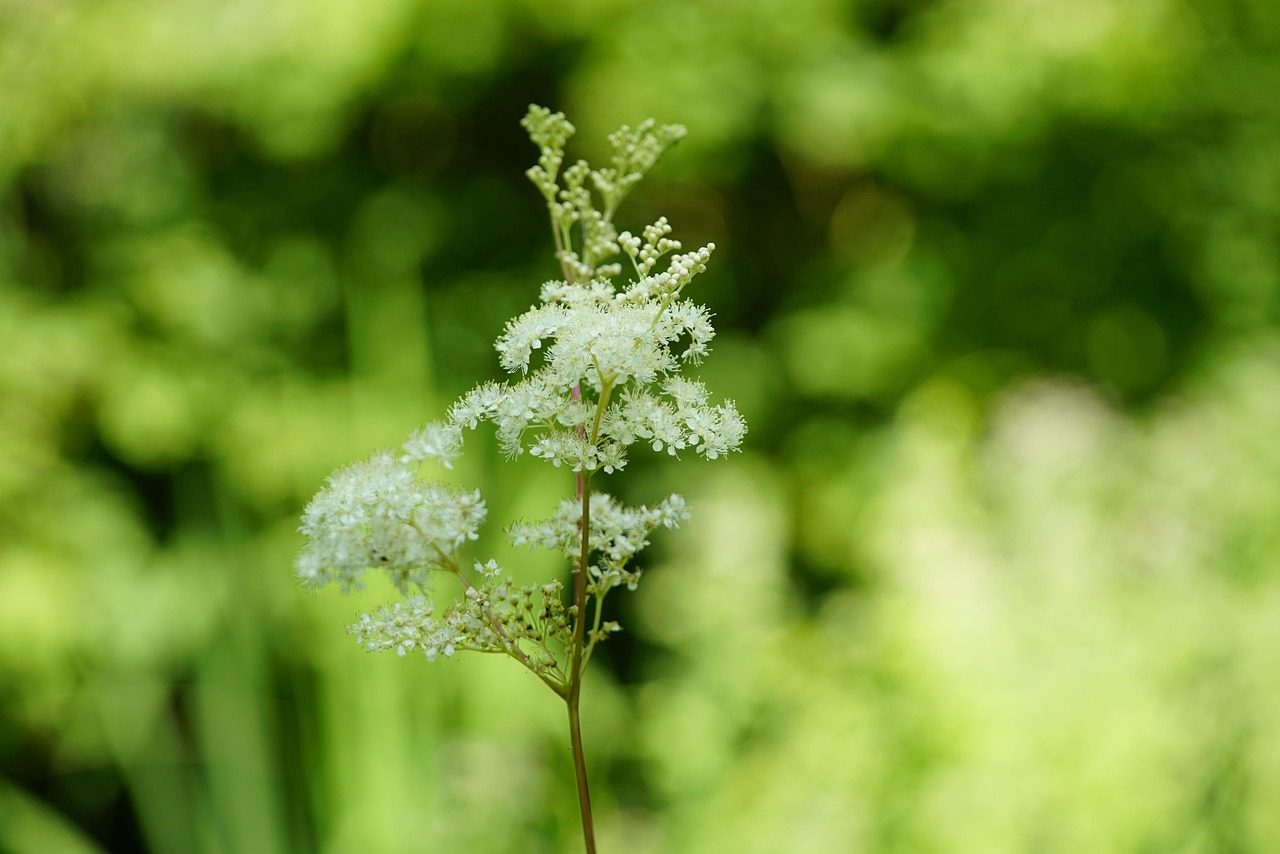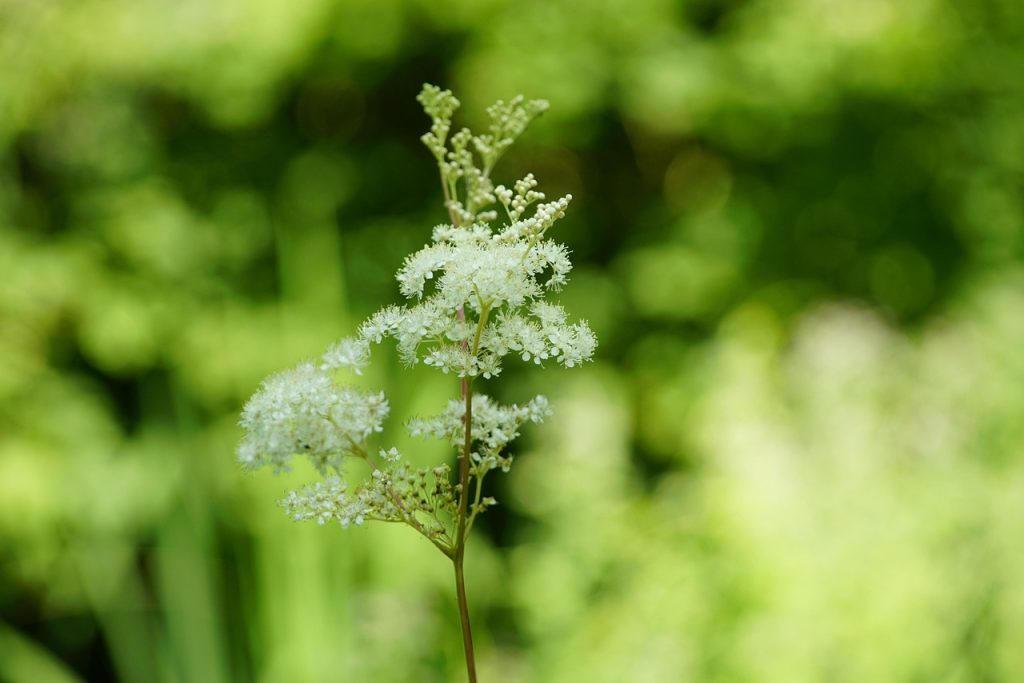Your cart is currently empty!

The Fragrant Healer: Medicinal Benefits of Meadowsweet Revealed
Discover Why Herbalists Still Turn to Medicinal Benefits of Meadowsweet Today
Graceful, fragrant and deeply healing, Meadowsweet has long been revered for its ability to ease pain, calm the stomach and soothe the spirit. A flowering perennial of damp meadows and streambanks, it has earned its place in the herbal apothecary as one of nature’s gentlest yet most effective remedies. The medicinal benefits of meadowsweet include support for inflammation, pain, and digestion — all without harsh effects. In a world that often isolates and standardizes, Meadowsweet reminds us of the power in whole-plant medicine.
Botanical Profile
Botanical name: Filipendula ulmaria (formerly Spiraea ulmaria)
Family: Rosaceae
Flowering 4 to 6 feet, Meadowsweet is often called Queen of the Meadow. This is not to be confused with Gravel Root (Eupatorium purpureum), which also is recognized as Queen of the Meadow. Other popular names include: Bridewort, Meadsweet, Dropwort, Lady of the Meadow, and Spirea (not to be confused with the common landscape shrub).
Meadowsweet is an herbaceous perennial. Whereas it is a native of Europe and western Asia, it was introduced and contentedly naturalized in eastern North America.

How to Grow Meadowsweet
Meadowsweet thrives in moist, rich, loamy soil and part shade—ideal for damp meadows, near ponds or shaded garden beds. It can be propagated by seed or by dividing its creeping rootstock. A layer of mulch helps retain soil moisture. Once established, it rewards the grower with tall, ferny stems and fragrant summer blooms. Hardy in zones 3–9.
Description & Scent
The flowers are phenomenally fragrant. Blooming all summer, the creamy white masses possess a strong, sweet scent. In contrast, the leaves curiously have the aroma of almonds. The flowers are used in wine and beer making. The satisfying smell lended Meadowsweet to being utilized as a strewing herb in homes.
For medicine, both leaves and flowers of Meadowsweet are gathered early in the blooming stage. They are used, without stems, fresh or dried.
Historical Significance
Historically, Meadowsweet held a place of honor. Its former Latin name Spiraea ulmaria is the root of the word “aspirin,” named by Bayer in the late 1800s when they isolated acetylsalicylic acid from plant sources. While this synthetic copy became the pharmaceutical giant’s famous pill, it lacked the buffering companions found in the whole plant and thus caused far more gastric distress.
Holistic herbalists, however, never isolate the components of the herb. It is used whole—for ailments that call for calm and relief.
Did You Know?
In the Middle Ages, meadowsweet was used to scent homes and churches, often strewn across floors for its sweet, almond-like fragrance. Queen Elizabeth I even preferred it over all other herbs to freshen her private chambers. Its name comes from “mead-sweet” — once used to flavor mead.
Medicinal Benefits of Meadowsweet
Meadowsweet as a wholesome herb is a rich and safe source of salicylic acid—nature’s pain reliever. Herbalists such as David Hoffmann advocate for its use in whole-plant form, especially when addressing digestive inflammation, as it soothes rather than irritates the lining of the stomach. The herb relies on a synergy of components that buffer and enhance its action to interact with the complex chemistry of the human body—something isolated aspirin cannot replicate. 1
Meadowsweet has been traditionally used as:
Anti-inflammatory: for arthritis, joint swelling, general inflammation
Pain-reliever: for headaches, back pain, toothaches
Digestive soother: for nausea, heartburn, indigestion, ulcers
Astringent: for infant diarrhea and loose stools
Diaphoretic: to reduce fever by promoting sweating
Diuretic: to relieve water retention (dropsy)
Antacid and anti-emetic: calming the stomach and reducing vomiting
It is especially cherished for its gentleness—powerful enough to relieve pain yet safe enough for children in appropriate doses.
Traditional Ways to Use Meadowsweet
As a gentle herbal tea for headaches or heartburn
Combined with peppermint for digestive blends
Infused into oils or salves for sore joints
Added to mead or honey for flavor and medicine
Preparation & Dosage
Infusion (tea): 1–2 tsp dried herb per cup of hot water. Steep 15 minutes. Adults may take 2–3 cups daily.
Tincture: 30–60 drops (1–2 mL) in water, up to three times daily for adults.
Note: Dosage should be reduced appropriately for infants, children, seniors.
As always, correct plant identification, quality harvesting and proper dosage are essential.
Contraindications & Cautions
While Meadowsweet is considered gentle and widely tolerated, there are exceptions:
Do not use in cases of salicylate sensitivity or allergy
Drug Interaction:
Anticoagulants (blood thinners) or other NSAIDS may interact with it, raising the risk of bleeding.
When in doubt, consult a holistic herbalist, especially if pregnant, breastfeeding or managing a serious health condition.
Medicinal Benefits of Meadowsweet – At a Glance
Gentle enough for children, powerful enough for inflammation
Supports both pain relief and digestion
One of nature’s best examples of whole-plant medicine working synergistically
Looking to explore the medicinal benefits of meadowsweet firsthand? Visit a local botanical garden and see if it’s in bloom — or better yet, consider growing this stately and useful herb in your own garden.
If you’re interested in exploring the constituents that make Meadowsweet so effective, the Dr. Duke’s Phytochemical and Ethnobotanical Databases offer a detailed look at its known plant compounds and traditional uses. Compiled by the late Dr. James A. Duke, a retired ethnobotanist with the USDA and one of my own professors at the School of Natural Healing, this searchable resource highlights the phytochemical properties and folk applications of Filipendula ulmaria. View Dr. Duke’s USDA database entry on Meadowsweet
FAQs
Is Meadowsweet safe for children?
Yes, when used appropriately and in lower doses.
Can I take Meadowsweet if I’m allergic to aspirin?
No. Meadowsweet contains natural salicylates and should be avoided by those with salicylate sensitivity or allergy.
What does Meadowsweet taste like?
It has a mildly sweet, slightly astringent flavor with aromatic and almond-like undertones, especially in the leaves.
Curious about the medicinal benefits of Meadowsweet? Feel free to explore our other plant profiles to learn more about trusted healing herbs. See other articles I have written.
References:
Cech, Richard A. “Richo.” Making Plant Medicine, Fourth Edition. Williams, OR, United States of America, Herbal Reeds LLC, 2022. pp. 225-226.
Grieve, Maud. “Meadowsweet.” A Modern Herbal: The Medicinal, Culinary, Cosmetic and Economic Properties. Cultivation and Folk-Lore of Herbs, Grasses, Fungi, Shrubs, & Trees with All Their Modern Scientific Uses. Dover Publications, New York, NY, 1982. p. 524-525.
1. Hofmann, David. Medical Herbalism: the science and practice of herbal medicine. Rochester, VT, United States of America, Healing Arts Press, 2003. pp. 186, 36, 550-551.
© 2025 Kellie (Kalili) Haszard. Published by Growing Traditions. All Rights Reserved.This article is intended for educational use only. Reproduction or redistribution of this material in whole or in part is not permitted without prior written permission from the author. Sharing via direct links is welcome, provided full credit is given to Growing Traditions with a clear link to the original content at www.growingtraditions.org. Thank you for respecting the time and care that went into creating this work.
